Combined Method for Evaluating Accessibility in Serious Games
Abstract
1. Introduction
2. Background and Related Work
2.1. Serious Games
2.2. Accessibility
3. Method and Case Study
4. Results and Discussion
5. Conclusions and Future Work
Author Contributions
Funding
Conflicts of Interest
References
- Belitski, M.; Heron, K. Expanding entrepreneurship education ecosystems. J. Manag. Dev. 2017, 36, 163–177. [Google Scholar] [CrossRef]
- Martin, F.; Betrus, A.K. Instructional simulations and games. In Digital Media for Learning; Springer: Cham, Germany, 2019; pp. 85–110. [Google Scholar]
- Cheng, M.T.; Chen, J.H.; Chu, S.J.; Chen, S.Y. The use of serious games in science education: A review of selected empirical research from 2002 to 2013. J. Comput. Educ. 2015, 2, 353–375. [Google Scholar] [CrossRef]
- He, W.; Xu, G.; Kruck, S.E. Online IS education for the 21st century. J. Inf Syst. Educ. 2019, 25, 1. [Google Scholar]
- Kazimoglu, C.; Kiernan, M.; Bacon, L.; Mackinnon, L. A serious game for developing computational thinking and learning introductory computer programming. Proc. Soc. Behav. Sci. 2012, 47, 1991–1999. [Google Scholar] [CrossRef]
- De Freitas, S.; Liarokapis, F. Serious games: A new paradigm for education? In Serious Games and Edutainment Applications; Springer: London, UK, 2011; pp. 9–23. [Google Scholar]
- Assaf, M.; van Hillegersberg, J.; Spil, T.; Arikat, N. Teachers’ perceptions about using serious games in formal education in Jordan: Possibilities and limitations. In Proceedings of the Engineering Education Conference, IEEE, Dubai, United Arab Emirates, 8–11 April 2019; pp. 436–441. [Google Scholar]
- Egenfeldt-Nielsen, S.; Heide Smith, J.; Pajares Tosca, S. Serious Games and gamification—When entertainment is not enough. In Understanding Video Games; Routledge: Abingdon, UK, 2015; pp. 247–280. [Google Scholar]
- Larson, K. Serious games and gamification in the corporate training environment: A literature review. Tech. Trends 2020, 64, 319–328. [Google Scholar] [CrossRef]
- World Health Organization (WHO). World Report on Disability. Available online: https://www.who.int/disabilities/world_report/2011/report/en/ (accessed on 10 May 2020).
- Meadows, M.L.; Caniglia, J.C. Using PhET simulations in the mathematics classroom. Math Teach 2019, 112, 386–389. [Google Scholar] [CrossRef]
- Interactive Simulations. PhET: Free Online Physics, Chemistry, Biology, Earth Science and Math Simulations. Available online: https://phet.colorado.edu/ (accessed on 25 April 2020).
- Acosta-Vargas, P.; Salvador-Ullauri, L.; Luján-Mora, S. A heuristic method to evaluate web accessibility for users with low vision. IEEE Access 2019, 7, 125634–125648. [Google Scholar] [CrossRef]
- World Wide Web Consortium. Web Content Accessibility Guidelines (WCAG) 2.1. Available online: https://www.w3.org/TR/WCAG21/ (accessed on 7 July 2020).
- World Wide Web Consortium (W3C). Web Content Accessibility Guidelines (WCAG) 2.2. Available online: https://www.w3.org/TR/2020/WD-WCAG22-20200227/ (accessed on 10 May 2020).
- Statista. Game-based Learning Market Revenue Worldwide in 2018 and 2024. Available online: https://www.statista.com/statistics/733616/game-based-learning-industry-revenue-world/ (accessed on 10 May 2020).
- Ainslie, K.E.; Walters, C.E.; Fu, H.; Bhatia, S.; Wang, H.; Xi, X.; Cattarino, L. Evidence of initial success for China exiting COVID-19 social distancing policy after achieving containment. Wellcome Open Res. 2020, 5, 81. [Google Scholar] [CrossRef] [PubMed]
- Schell, J. The Art of Game Design: A Book of Lenses; CRC Press: Boka Raton, FL, USA, 2019. [Google Scholar]
- Abt, C. Serious Games; University Press of America: Millburn, NJ, USA, 1987; p. 196. [Google Scholar]
- López, J.M.; Medina, N.M.; de Lope, R.P. Interaction in video games for people with impaired visual function: Improving accessibility. In Proceedings of the International Conference on Human Computer Interaction, ACM, Salamanca, Spain, 13–16 September 2016; pp. 1–2. [Google Scholar]
- Jaramillo-Alcázar, A.; Luján-Mora, S.; Salvador-Ullauri, L. Accessibility assessment of mobile serious games for people with cognitive impairments. In Proceedings of the International Conference on Information Systems and Computer Science, IEEE, Quito, Ecuador, 23–25 November 2017; pp. 323–328. [Google Scholar]
- Salvador-Ullauri, L.; Acosta-Vargas, P.; Luján-Mora, S. Accessibility Evaluation of Video Games for Users with Cognitive Disabilities; Springer: Cham, Germany, 2020; pp. 853–859. [Google Scholar]
- World Wide Web Consortium (W3C). Web Content Accessibility Guidelines (WCAG) 2.0. Available online: https://www.w3.org/TR/WCAG20/ (accessed on 3 August 2020).
- Park, H.J.; Kim, S.B. Guidelines of serious game accessibility for the disabled. In Proceedings of the International Conference on Information Science and Applications, IEEE, Suwon, South Korea, 24–26 June 2013; pp. 1–3. [Google Scholar]
- Araújo, M.C.; Façanha, A.R.; Darin, T.G.; Sánchez, J.; Andrade, R.M.; Viana, W. Mobile Audio Games Accessibility Evaluation for Users Who are Blind; Springer: Cham, Germany, 2017; pp. 242–259. [Google Scholar]
- Cairns, P.; Power, C.; Barlet, M.; Haynes, G. Future design of accessibility in games: A design vocabulary. Int. J. Hum. Comput. Stud. 2019, 131, 64–71. [Google Scholar] [CrossRef]
- Waki, A.L.; Fujiyoshi, G.S.; Almeida, L.D. Games Accessibility for Deaf People: Evaluating Integrated Guidelines; Springer: Cham, Germany, 2015; pp. 493–504. [Google Scholar]
- Westin, T.; Ku, J.J.; Dupire, J.; Hamilton, I. Game Accessibility Guidelines and WCAG 2.0–A Gap Analysis; Springer: Cham, Germany, 2018; pp. 270–279. [Google Scholar]
- Wilson, A.; Crabb, M. W3C Accessibility guidelines for mobile games. Comput. Games J. 2018, 7, 49–61. [Google Scholar]
- Spyridonis, F.; Daylamani-Zad, D. A serious game to improve engagement with web accessibility guidelines. Behav. Inf. Technol. 2020, 1–19. [Google Scholar] [CrossRef]
- Moreno, L.; Valencia, X.; Pérez, J.; Arrue, M. Exploring the Web navigation strategies of people with low vision. In Proceedings of the International Conference on Human Computer Interaction, ACM, Palma, Spain, 12–14 September 2018; p. 13. [Google Scholar]
- World Health Organization (WHO). Blindness and Vision Impairment. Available online: https://www.who.int/news-room/fact-sheets/detail/blindness-and-visual-impairment (accessed on 3 September 2020).
- Bourne, R.R.; Flaxman, S.R.; Braithwaite, T.; Cicinelli, M.V.; das, A.; Jonas, J.B.; Naidoo, K. Magnitude, temporal trends, and projections of the global prevalence of blindness and distance and near vision impairment: A systematic review and meta-analysis. Lancet. Glob. Heal. 2019, 5, e888–e897. Available online: https://linkinghub.elsevier.com/retrieve/pii/S2214109X17302930 (accessed on 26 January 2019). [CrossRef]
- Brajnik, G. Beyond Conformance: The Role of Accessibility Evaluation Methods; Springer: Berlin, Germany, 2008; pp. 63–80. [Google Scholar]
- The Paciello Group. Colour Contrast Analyser. Available online: https://developer.paciellogroup.com/resources/contrastanalyser/ (accessed on 20 June 2020).
- University of Maryland. Photosensitive Epilepsy Analysis Tool. Available online: https://trace.umd.edu/peat (accessed on 20 June 2020).
- Acosta-Vargas, P.; Salvador-Ullauri, L. Dataset Evaluation in Serious Games. Mendeley Data. Available online: https://data.mendeley.com/datasets/t2tr35ww4c/5 (accessed on 3 September 2020).
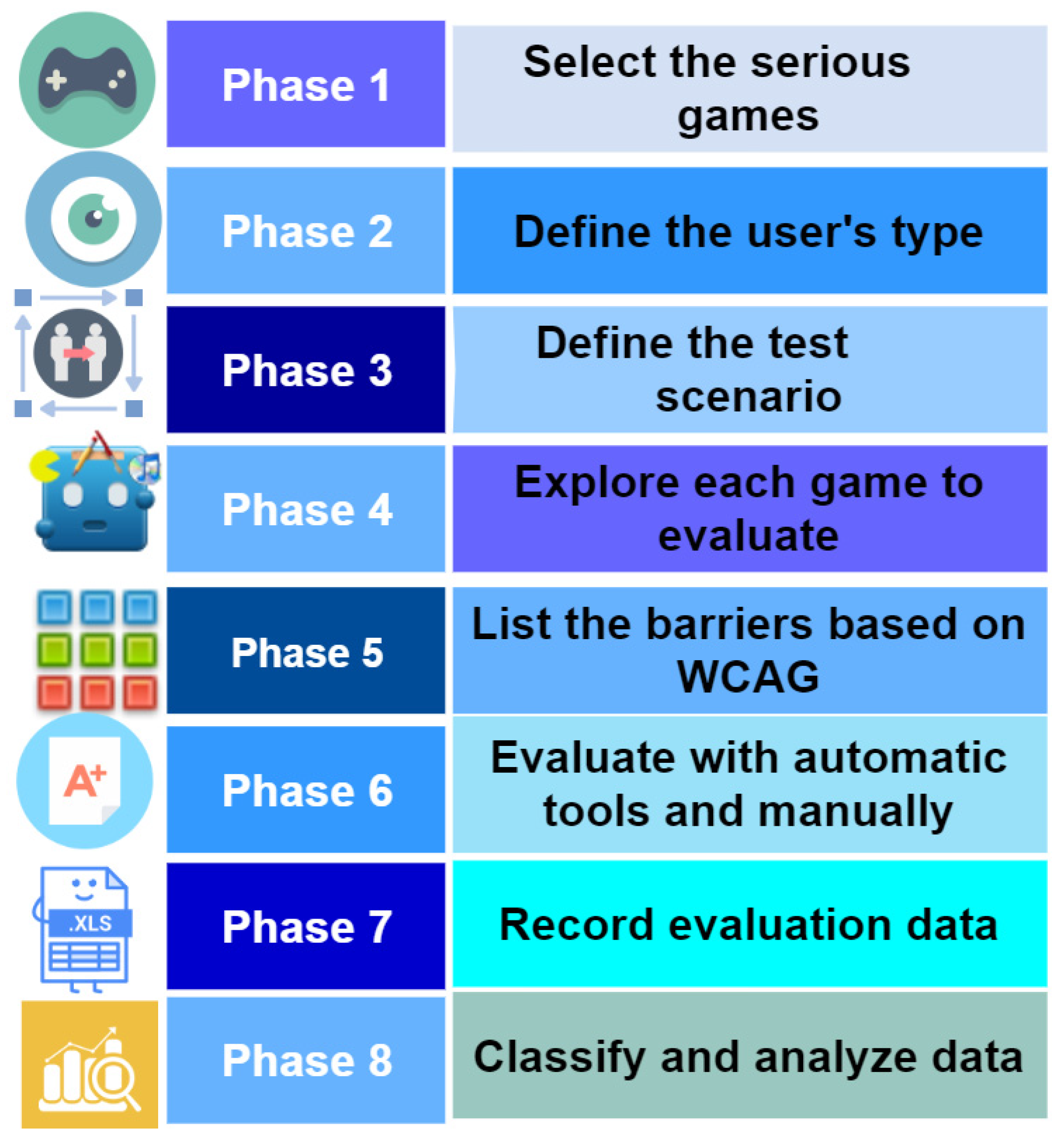
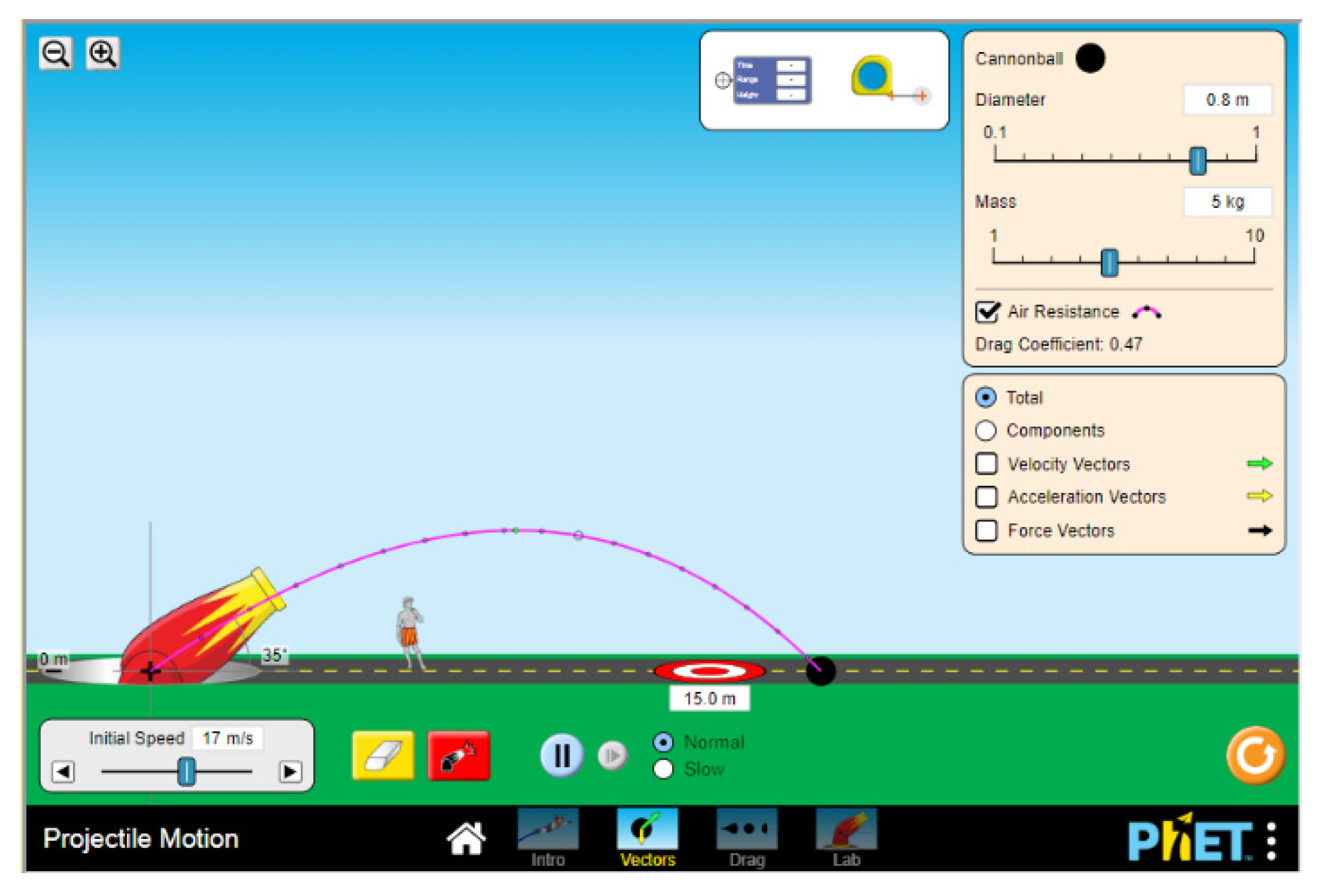
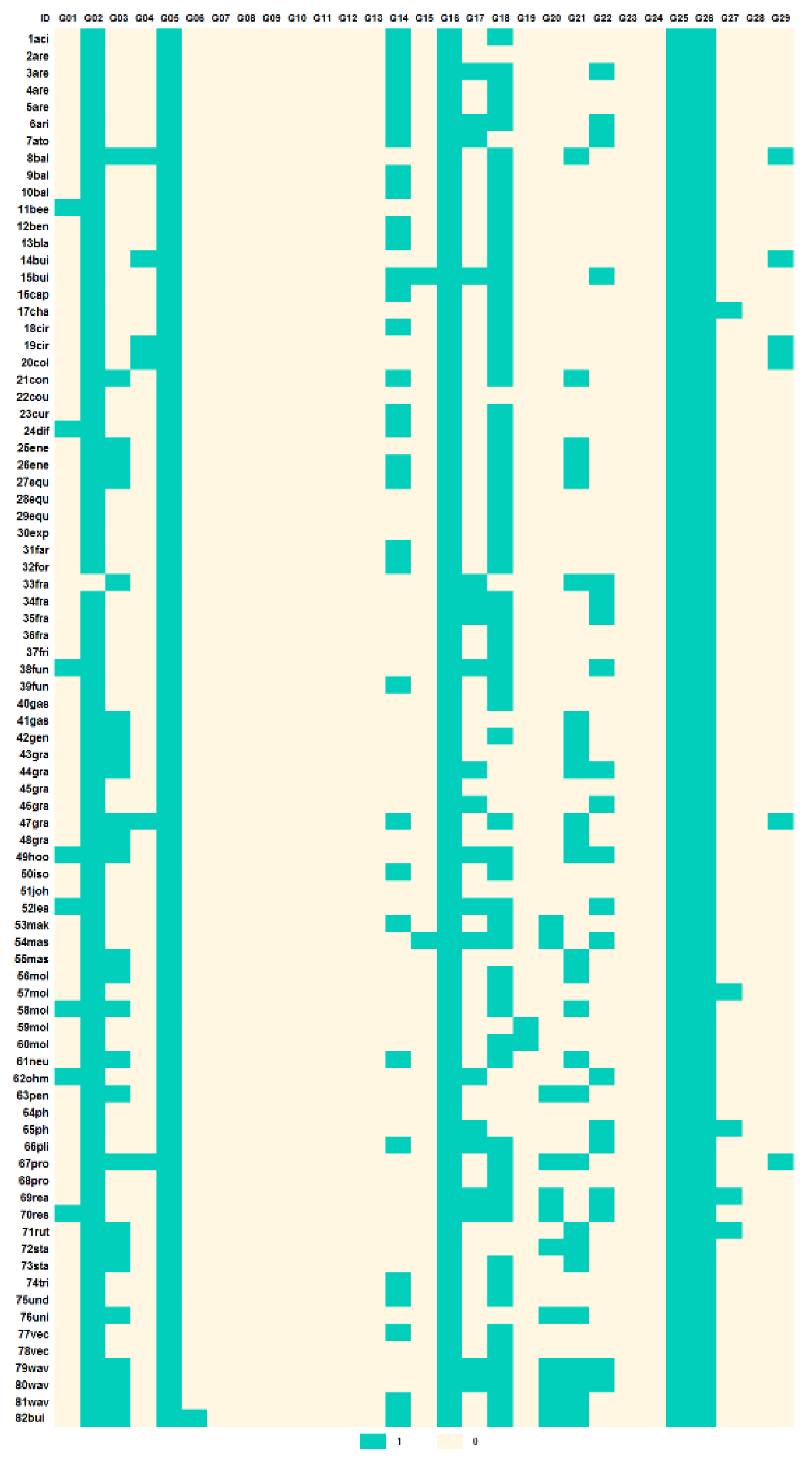
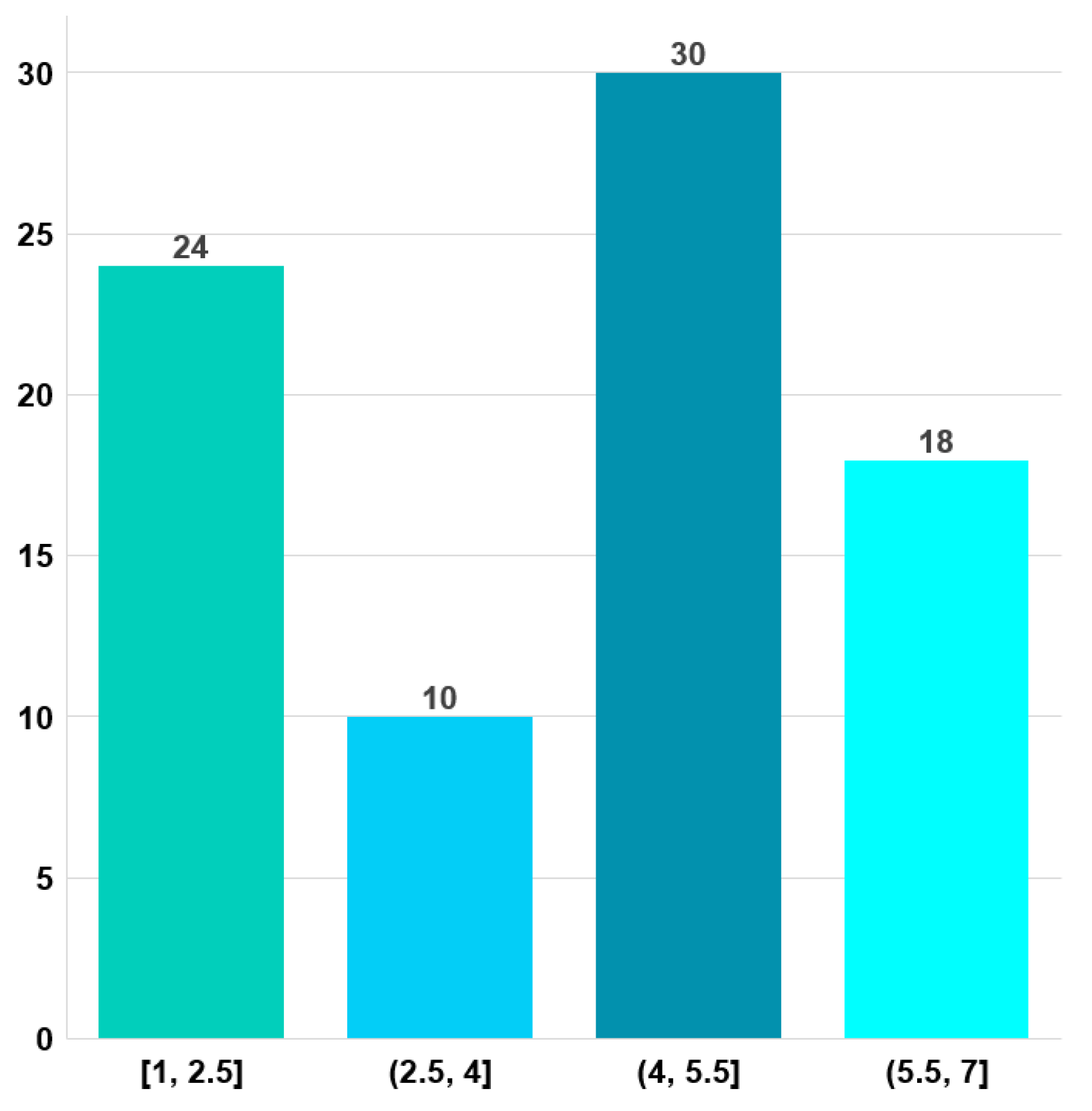
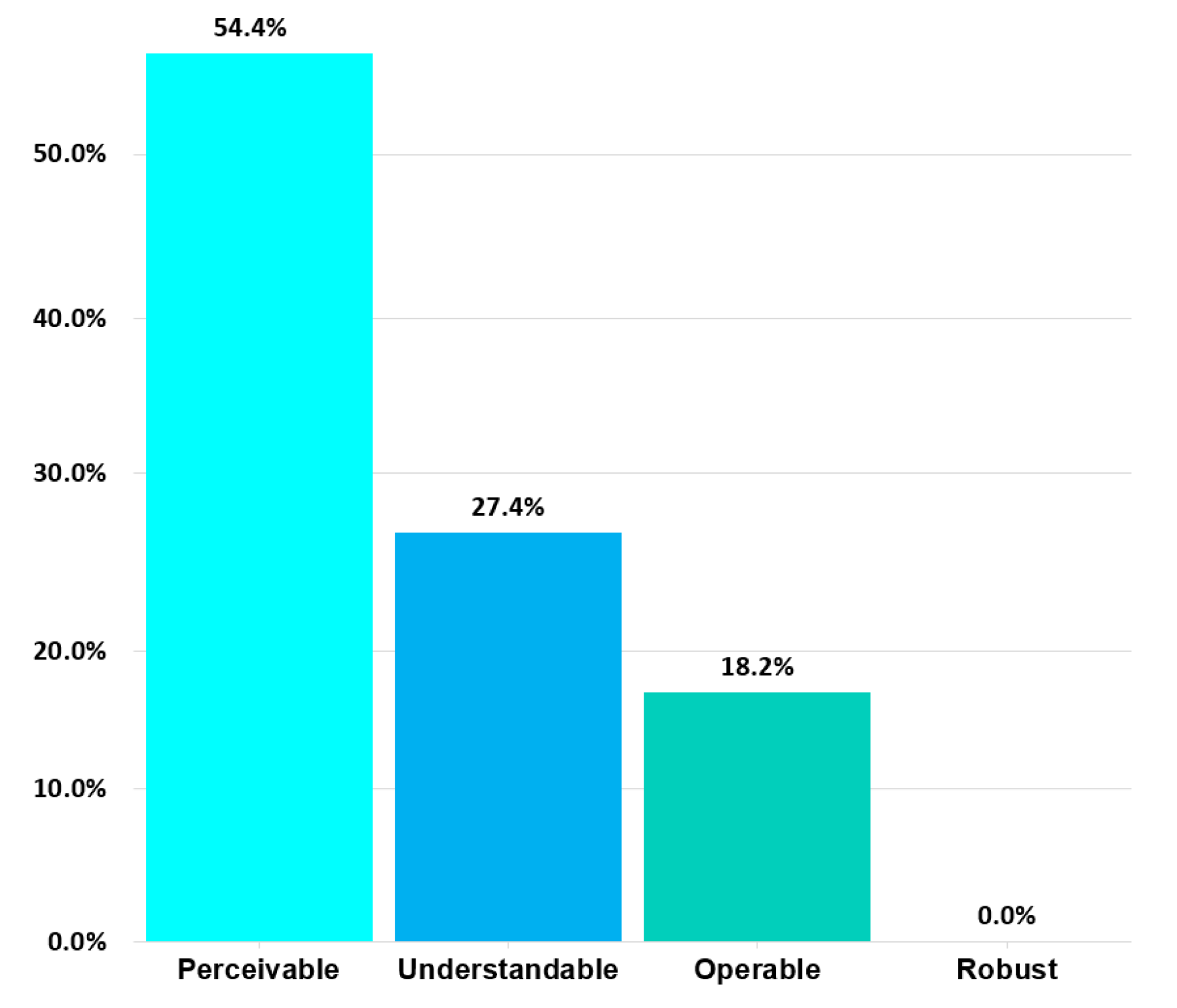
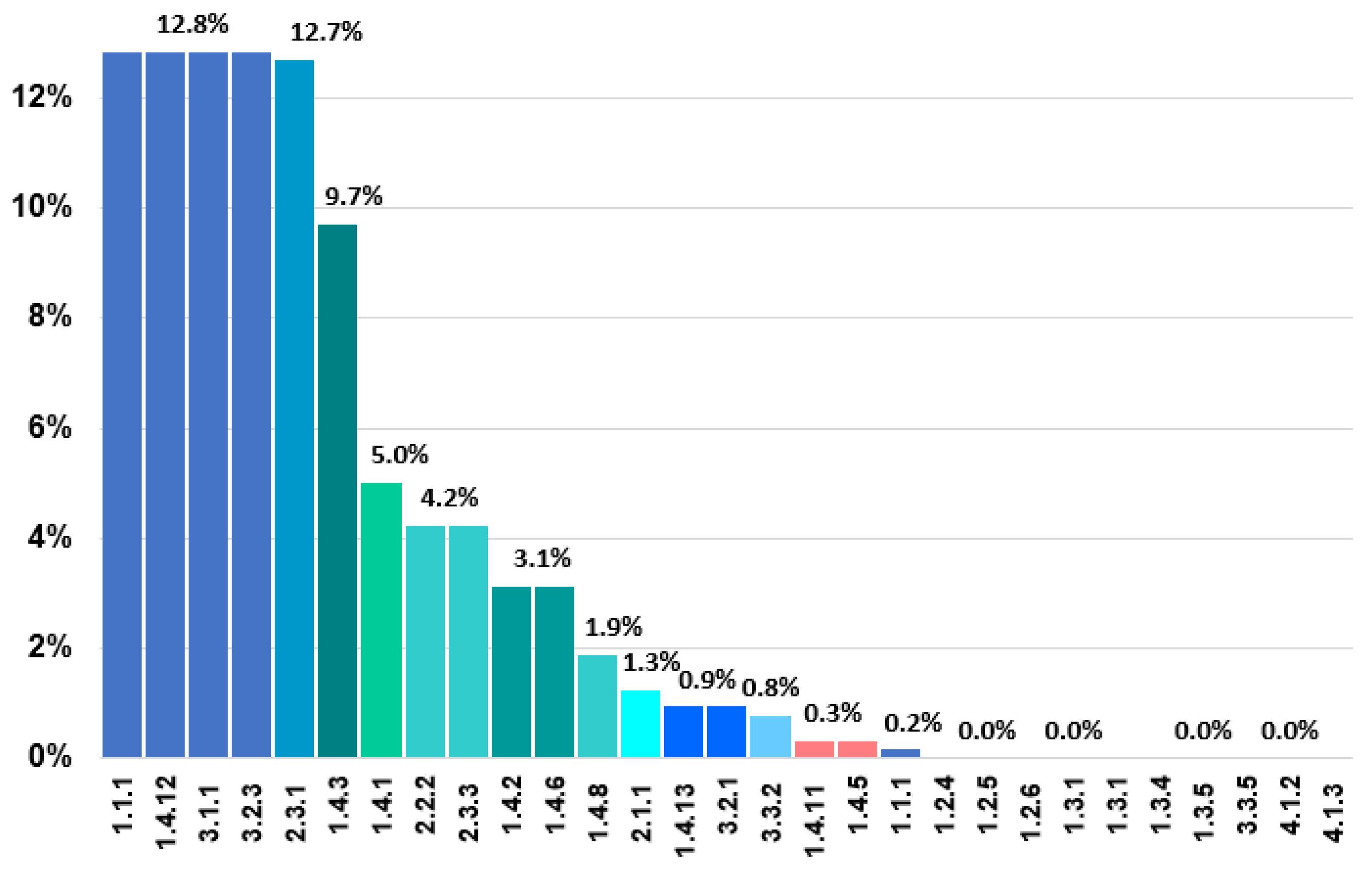
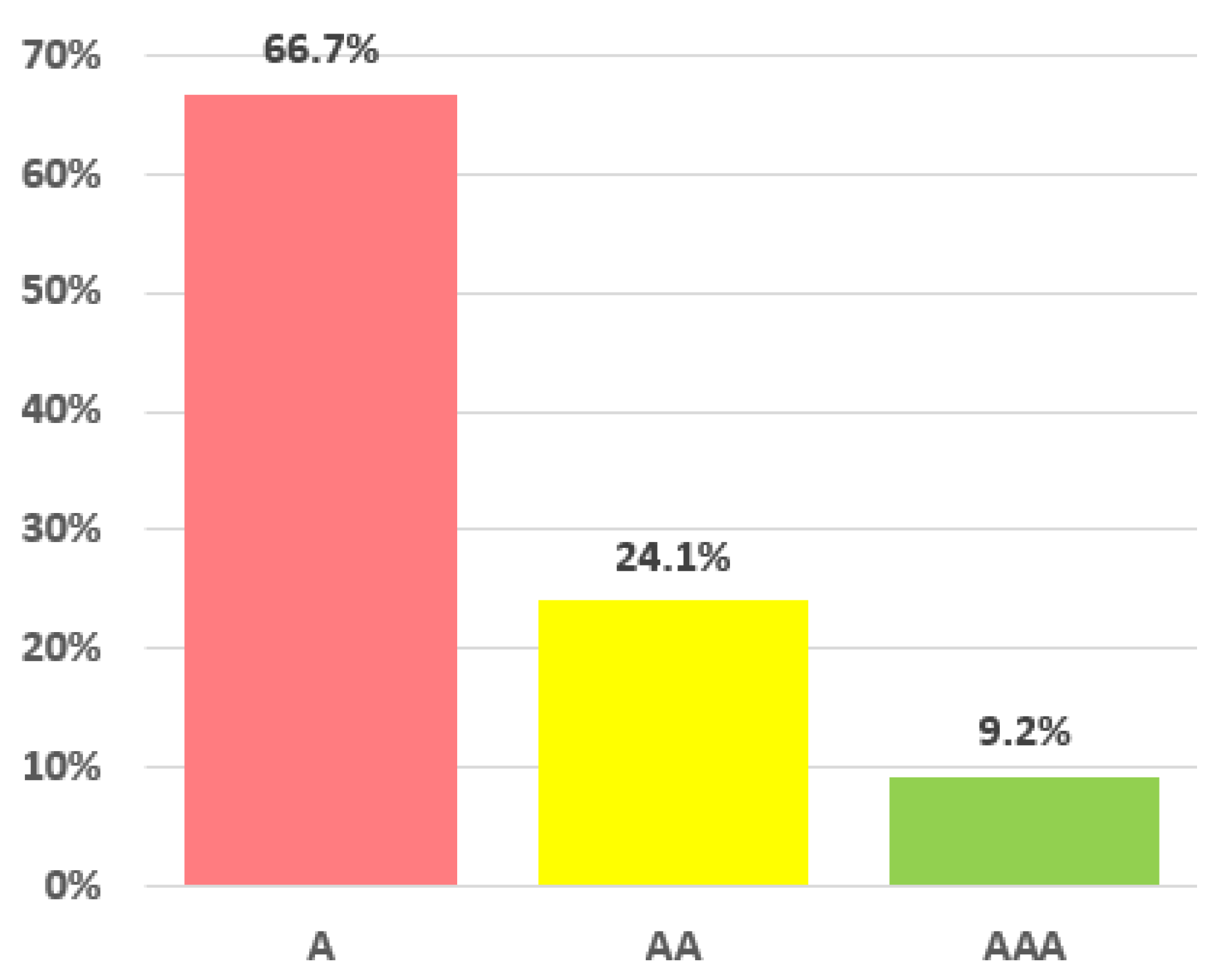
| ID | URL | Subject |
|---|---|---|
| 1aci | acid-base-solutions/1.2.24/acid-base-solutions_es.html | Chemistry |
| 2are | area-builder/1.1.20/area-builder_es.html | Math |
| 3are | area-model-algebra/1.2.1/area-model-algebra_es.html | Math |
| 4are | area-model-decimals/1.2.1/area-model-decimals_es.html | Math |
| 5are | area-model-introduction/1.2.1/area-model-introduction_es.html | Math |
| 6ari | area-model-multiplication/1.2.1/area-model-multiplication_es.html | Math |
| 7ato | arithmetic/1.0.24/arithmetic_es.html | Math |
| 8bal | atomic-interactions/1.1.0/atomic-interactions_es.html | Chemistry |
| 9bal | balancing-act/1.1.24/balancing-act_es.html | Math |
| 10bal | balancing-chemical-equations/1.2.10/balancing-chemical-equations_es.html | Chemistry |
| 11bee | balloons-and-static-electricity/1.4.14/balloons-and-static-electricity_es.html | Earth science |
| 12ben | beers-law-lab/1.4.18/beers-law-lab_es.html | Physics |
| 13bla | bending-light/1.1.20/bending-light_es.html | Physics |
| 14bui | blackbody-spectrum/1.0.7/blackbody-spectrum_es.html | Earth science |
| 15bui | build-a-fraction/1.0.12/build-a-fraction_es.html | Math |
| 16cap | build-an-atom/1.6.14/build-an-atom_es.html | Physics |
| 17cha | capacitor-lab-basics/1.6.19/capacitor-lab-basics_es.html | Physics |
| 18cir | charges-and-fields/1.0.47/charges-and-fields_es.html | Physics |
| 19cir | circuit-construction-kit-dc/1.1.5/circuit-construction-kit-dc_es.html | Physics |
| 20col | circuit-construction-kit-dc-virtual-lab/1.1.5/circuit-construction-kit-dc-virtual-lab_es.html | Physics |
| 21con | color-vision/1.1.23/color-vision_es.html | Biology |
| 22cou | concentration/1.3.20/concentration_es.html | Physics |
| 23cur | curve-fitting/1.0.0/curve-fitting_es.html | Math |
| 24dif | coulombs-law/1.0.9/coulombs-law_es.html | Physics |
| 25ene | diffusion/1.0.4/diffusion_es.html | Earth science |
| 26ene | energy-forms-and-changes/1.0.11/energy-forms-and-changes_es.html | Physics |
| 27equ | energy-skate-park-basics/1.1.19/energy-skate-park-basics_es.html | Physics |
| 28equ | equality-explorer/1.0.12/equality-explorer_es.html | Math |
| 29equ | equality-explorer-basics/1.0.12/equality-explorer-basics_es.html | Math |
| 30exp | equality-explorer-two-variables/1.0.12/equality-explorer-two-variables_es.html | Math |
| 31far | expression-exchange/1.1.14/expression-exchange_es.html | Math |
| 32for | faradays-law/1.1.23/faradays-law_es.html | Physics |
| 33fra | forces-and-motion-basics/2.3.16/forces-and-motion-basics_es.html | Physics |
| 34fra | fractions-equality/1.1.1/fractions-equality_es.html | Math |
| 35fra | fraction-matcher/1.2.1/fraction-matcher_es.html | Math |
| 36fra | fractions-intro/1.0.12/fractions-intro_es.html | Math |
| 37fri | fractions-mixed-numbers/1.0.12/fractions-mixed-numbers_es.html | Math |
| 38fun | friction/1.5.10/friction_es.html | Physics |
| 39fun | function-builder/1.0.23/function-builder_es.html | Math |
| 40gas | function-builder-basics/1.0.14/function-builder-basics_es.html | Math |
| 41gas | gases-intro/1.0.5/gases-intro_es.html | Earth science |
| 42gen | gas-properties/1.0.4/gas-properties_es.html | Earth science |
| 43gra | gene-expression-essentials/1.0.16/gene-expression-essentials_es.html | Biology |
| 44gra | graphing-lines/1.3.10/graphing-lines_es.html | Math |
| 45gra | graphing-quadratics/1.1.5/graphing-quadratics_es.html | Math |
| 46gra | graphing-slope-intercept/1.1.9/graphing-slope-intercept_es.html | Math |
| 47gra | gravity-and-orbits/1.1.15/gravity-and-orbits_es.html | Physics |
| 48gra | gravity-force-lab/2.2.0/gravity-force-lab_es.html | Physics |
| 49hoo | gravity-force-lab-basics/1.0.0/gravity-force-lab-basics_es.html | Physics |
| 50iso | hookes-law/1.0.23/hookes-law_es.html | Chemistry |
| 51joh | isotopes-and-atomic-mass/1.1.9/isotopes-and-atomic-mass_es.html | Chemistry |
| 52lea | john-travoltage/1.5.12/john-travoltage_es.html | Physics |
| 53mak | least-squares-regression/1.1.20/least-squares-regression_es.html | Math |
| 54mas | make-a-ten/1.0.16/make-a-ten_es.html | Math |
| 55mas | masses-and-springs/1.0.10/masses-and-springs_es.html | Math |
| 56mol | masses-and-springs-basics/1.0.9/masses-and-springs-basics_es.html | Physics |
| 57mol | molarity/1.5.1/molarity_es.html | Chemistry |
| 58mol | molecules-and-light/1.4.14/molecules-and-light_es.html | Earth science |
| 59mol | molecule-shapes/1.2.8/molecule-shapes_es.html | Chemistry |
| 60mol | molecule-shapes-basics/1.2.8/molecule-shapes-basics_es.html | Chemistry |
| 61neu | neuron/1.1.18/neuron_es.html | Biology |
| 62ohm | ohms-law/1.4.7/ohms-law_es.html | Math |
| 63pen | pendulum-lab/1.0.15/pendulum-lab_es.html | Math |
| 64ph | ph-scale/1.3.4/ph-scale_es.html | Earth science |
| 65ph | ph-scale-basics/1.3.4/ph-scale-basics_es.html | Biology |
| 66pli | plinko-probability/1.1.18/plinko-probability_es.html | Math |
| 67pro | projectile-motion/1.0.15/projectile-motion_es.html | Math |
| 68pro | proportion-playground/1.0.15/proportion-playground_es.html | Math |
| 69rea | reactants-products-and-leftovers/1.2.11/reactants-products-and-leftovers_es.html | Chemistry |
| 70res | resistance-in-a-wire/1.6.9/resistance-in-a-wire_es.html | Math |
| 71rut | rutherford-scattering/1.1.9/rutherford-scattering_es.html | Chemistry |
| 72sta | states-of-matter-basics/1.1.8/states-of-matter-basics_es.html | Physics |
| 73sta | states-of-matter/1.1.10/states-of-matter_es.html | Physics |
| 74tri | trig-tour/1.0.22/trig-tour_es.html | Math |
| 75und | under-pressure/1.1.18/under-pressure_es.html | Earth science |
| 76uni | unit-rates/1.0.17/unit-rates_es.html | Math |
| 77vec | vector-addition/1.0.0/vector-addition_es.html | Math |
| 78vec | vector-addition-equations/1.0.0/vector-addition-equations_es.html | Math |
| 79wav | wave-interference/2.0.2/wave-interference_es.html | Earth science |
| 80wav | waves-intro/1.0.2/waves-intro_es.html | Earth science |
| 81wav | wave-on-a-string/1.1.22/wave-on-a-string_es.html | Earth science |
| 82bui | build-a-molecule/latest/build-a-molecule_en.html | Chemistry |
| Guideline | Barrier | WCAG 2.1 | Success Criteria | Level |
|---|---|---|---|---|
| G01 | Accessible keyboard | Operable | 2.1.1 | A |
| G02 | Luminance flash failures | Operable | 2.3.1 | A |
| G03 | Animation from Interactions | Operable | 2.3.3 | AAA |
| G04 | Content hovering over focus | Perceivable | 1.4.13 | AA |
| G05 | Easy to read font | Perceivable | 1.1.1 | A |
| G06 | Text alternatives | Perceivable | 1.1.1 | A |
| G07 | Subtitled | Perceivable | 1.2.4 | AA |
| G08 | Automatic transcripts | Perceivable | 1.2.5 | AA |
| G09 | Sign language | Perceivable | 1.2.6 | AAA |
| G10 | Information and relationships | Perceivable | 1.3.1 | A |
| G11 | Sensory characteristics | Perceivable | 1.3.1 | A |
| G12 | Adjust display settings | Perceivable | 1.3.4 | AA |
| G13 | Interface rearrangement | Perceivable | 1.3.5 | AA |
| G14 | Use of color | Perceivable | 1.4.1 | A |
| G15 | Contrast without text | Perceivable | 1.4.11 | AA |
| G16 | Well-spaced elements | Perceivable | 1.4.12 | A |
| G17 | Good audio techniques | Perceivable | 1.4.2 | A |
| G18 | Contrast (Minimum) | Perceivable | 1.4.3 | AA |
| G19 | Images as sharp as possible | Perceivable | 1.4.5 | AA |
| G20 | Visual presentation | Perceivable | 1.4.8 | AAA |
| G21 | Pause, stop, hide | Perceivable | 2.2.2 | A |
| G22 | Contrast (Enhanced) | Perceivable | 1.4.6 | AAA |
| G23 | Screen reader support | Robust | 4.1.2 | A |
| G24 | Status messages | Robust | 4.1.3 | AA |
| G25 | Language | Understandable | 3.1.1 | A |
| G26 | Consistent navigation | Understandable | 3.2.3 | AA |
| G27 | Labels or instructions | Understandable | 3.3.2 | A |
| G28 | Help | Understandable | 3.3.5 | AAA |
| G29 | On Focus | Understandable | 3.2.1 | A |
| Guideline | Barrier | WCAG 2.1 (Principle) | Success Criteria | Level | Total | % |
|---|---|---|---|---|---|---|
| G01 | Accessible keyboard | Operable | 2.1.1 | A | 8 | 1.3 |
| G02 | Luminance flash failures | Operable | 2.3.1 | A | 81 | 13 |
| G03 | Animation from Interactions | Operable | 2.3.3 | AAA | 27 | 4.2 |
| G04 | Content hovering over focus | Perceivable | 1.4.13 | AA | 6 | 0.9 |
| G05 | Easy to read font | Perceivable | 1.1.1 | A | 82 | 13 |
| G06 | Text alternatives | Perceivable | 1.1.1 | A | 1 | 0.2 |
| G07 | Subtitled | Perceivable | 1.2.4 | AA | 0 | 0 |
| G08 | Automatic transcripts | Perceivable | 1.2.5 | AA | 0 | 0 |
| G09 | Sign language | Perceivable | 1.2.6 | AAA | 0 | 0 |
| G10 | Information and relationships | Perceivable | 1.3.1 | A | 0 | 0 |
| G11 | Sensory characteristics | Perceivable | 1.3.1 | A | 0 | 0 |
| G12 | Adjust display settings | Perceivable | 1.3.4 | AA | 0 | 0 |
| G13 | Interface rearrangement | Perceivable | 1.3.5 | AA | 0 | 0 |
| G14 | Use of color | Perceivable | 1.4.1 | A | 32 | 5 |
| G15 | Contrast without text | Perceivable | 1.4.11 | AA | 2 | 0.3 |
| G16 | Well-spaced elements | Perceivable | 1.4.12 | A | 82 | 13 |
| G17 | Good audio techniques | Perceivable | 1.4.2 | A | 20 | 3.1 |
| G18 | Contrast (Minimum) | Perceivable | 1.4.3 | AA | 62 | 9.7 |
| G19 | Images as sharp as possible | Perceivable | 1.4.5 | AA | 2 | 0.3 |
| G20 | Visual presentation | Perceivable | 1.4.8 | AAA | 12 | 1.9 |
| G21 | Pause, stop, hide | Perceivable | 2.2.2 | A | 27 | 4.2 |
| G22 | Contrast (Enhanced) | Perceivable | 1.4.6 | AAA | 20 | 3.1 |
| G23 | Screen reader support | Robust | 4.1.2 | A | 0 | 0 |
| G24 | Status messages | Robust | 4.1.3 | AA | 0 | 0 |
| G25 | Language | Understandable | 3.1.1 | A | 82 | 13 |
| G26 | Consistent navigation | Understandable | 3.2.3 | AA | 82 | 13 |
| G27 | Labels or instructions | Understandable | 3.3.2 | A | 5 | 0.8 |
| G28 | Help | Understandable | 3.3.5 | AAA | 0 | 0 |
| G29 | On Focus | Understandable | 3.2.1 | A | 6 | 0.9 |
© 2020 by the authors. Licensee MDPI, Basel, Switzerland. This article is an open access article distributed under the terms and conditions of the Creative Commons Attribution (CC BY) license (http://creativecommons.org/licenses/by/4.0/).
Share and Cite
Salvador-Ullauri, L.; Acosta-Vargas, P.; Gonzalez, M.; Luján-Mora, S. Combined Method for Evaluating Accessibility in Serious Games. Appl. Sci. 2020, 10, 6324. https://doi.org/10.3390/app10186324
Salvador-Ullauri L, Acosta-Vargas P, Gonzalez M, Luján-Mora S. Combined Method for Evaluating Accessibility in Serious Games. Applied Sciences. 2020; 10(18):6324. https://doi.org/10.3390/app10186324
Chicago/Turabian StyleSalvador-Ullauri, Luis, Patricia Acosta-Vargas, Mario Gonzalez, and Sergio Luján-Mora. 2020. "Combined Method for Evaluating Accessibility in Serious Games" Applied Sciences 10, no. 18: 6324. https://doi.org/10.3390/app10186324
APA StyleSalvador-Ullauri, L., Acosta-Vargas, P., Gonzalez, M., & Luján-Mora, S. (2020). Combined Method for Evaluating Accessibility in Serious Games. Applied Sciences, 10(18), 6324. https://doi.org/10.3390/app10186324








